Midsize Three-Row Crossover Comparison Test

2016 might just go down as the year in which the crossover SUV eclipsed the traditional car.
This past summer crossovers and SUVs finally started outselling cars in North America, making it clear that the market has shifted and these all-purpose tall wagons have what families want.
We gathered the latest and best midsize three-row crossovers for a big AutoGuide.com comparison, each of them in fully-loaded trim so we could get a taste of every possible feature they offer. While the market is flooded with subcompact and compact crossover runabouts, most families would gladly jump to the midsize segment for the larger cargo space and a handy third row that is rarely comfortable in this segment, but does make it possible to be the hero shuttling around extended family for the holidays or other occasional passenger duties. If you use a third row regularly, the minivan or a large SUV remain the vehicle of choice in our eyes.
Get the Flash Player to see this player.
Our test revolves around the 2016 Mazda CX-9 Signature we’ve had as a long-term tester for several months. It brings a new level of refinement to the interior, along with impressive efficiency from its 2.5L turbo-four, but will its stunning good looks be enough to make us overlook its shortcomings in cargo and passenger space?
To put the CX-9 to the ultimate test, we collected the Honda Pilot, Hyundai Santa Fe, Kia Sorento, and all-new GMC Acadia, which represents the new wave of GM midsize crossovers hitting the market.
SEE MORE: 2016 Ford Explorer vs 2016 Honda Pilot
Notable absences include the Ford Explorer, the top seller in this segment, but in previous tests we’ve found it has fallen behind the curve in terms of quality and value, so we passed on it. The updated 2017 Toyota Highlander and Nissan Pathfinders were not yet available at the time of the test.
So which of these family haulers gives you the most bang for your buck and all-around versatility?
Before we get into each individual vehicle’s strengths and weaknesses, here are the key specifications:
5th Place: 2016 Mazda CX-9
How did a car we love so much end up in fifth? Essentially, it was a numbers game.
We’ve gotten to know the Mazda CX-9 better than any of these vehicles over the last few months of our long-term test, so the honeymoon is over and it has had to show its true character, flaws and endearing traits alike.
Like any Mazda, it drives well, with its long, wide and low profile hugging the ground and delivering sharper handling without seemingly any compromises in comfort. However, that low roof means there are practical compromises, including limited cargo room, less passenger space and a tailgate that I’ve dinged my head against at least half a dozen times.
SEE ALSO: 2016 Mazda CX-9 long-term test
On the plus side, we love this turbo four-cylinder’s best-in-test 310 lb-ft of torque and the way it picks up the CX-9 and surges ahead while still earning the best EPA combined rating in this group. Okay, we know it’s a minivan substitute, but heck, it still gives us a bit of a thrill the way it takes off.
But this segment just isn’t about driving dynamics, and in addition to the CX-9’s limited cargo and passenger space, its rakish looks and lovely interior can’t make up for some notable missing features — namely ventilated seats and a 360º backup cam — and an infotainment system that is often clunky and aggravating.
Although it lags behind its competitors in the areas that matter most in this segment, for those looking for a stylish driver’s crossover without the need to measure max cargo capacity, the CX-9 is a good fit for those that value quality over quantity.
LOVE IT
- Sexy styling
- Great handling
- Beautiful interior
- Powerful and efficient
LEAVE IT
- Clunky HMI
- Mediocre cargo capacity
- Short on features
4th Place: 2016 Honda Pilot
The Pilot does everything you would expect from a Honda. Although by no means the largest of the vehicles on the outside, it delivers a fair chunk more cargo space and passenger room than any of these midsizers while delivering respectable efficiency.
It’s somewhat dull to look at, but it’s easy to get in and out of, has a nice and high seating position and great visibility all around, and all three rows offer excellent seating space. The trunk is also the most spacious here, and the cabin has spots for all your drinks, devices and charging cables. It’s just plain good all-around.
Well, except for the nav system. This top-of-the-line model is very nice, but Honda’s touchscreen-based infotainment interface remains one of the more challenging systems on the market, every action followed by a frustrating delay, and convoluted menus and layout.
SEE ALSO: 2016 Honda Pilot Review
While the 3.5L V6 delivers decent power, it’s the heaviest of the bunch here and struggles to get up to speed if you’re in a hurry, and the new nine-speed transmission is sometimes too slow and sometimes too eager. Combine that with the hefty weight and widest, tallest body, and the Pilot tends to lurch around like a roly-poly couch on wheels, so it’s the least pleasant to drive of this bunch. But honestly, that’s more a compliment to the others in this comparison than a condemnation of the Pilot; it’s still a fine vehicle to drive for a midsize SUV.
The Pilot also maxes out the feature sheet, with all the latest electronic driver aids like adaptive cruise, lane-keep assist, rear cross-traffic alert and more, but most of the others have them too, and the Pilot is a few thousand dollars more expensive than the Koreans or the Mazda in Top trim, but at least it has cooled seats.
LOVE IT
- Stellar fuel efficiency
- Great cargo capacity
- Driving Tech
LEAVE IT
- Painful infotainment system
- Feels sluggish
3rd Place: 2017 GMC Acadia
The GMC Acadia is the newest kid on the block in the midsize crossover segment, with this second-generation 2017 model just arriving on the scene this summer in a much smaller, more efficient package. But does it still have the practicality that drove the success of the first generation?
Umm, no, not really. GMC has very much traded size for efficiency, with a smaller footprint and much less weight, so cargo space shrinks a lot. It still has plenty of useful passenger space, the second row spacious and comfy with captain’s chairs that can even flip up and forward, allowing easy access to the third row with a child seat anchored in place. The third row is even livable for adults, so it should be great for children.
SEE ALSO: 2017 GMC Acadia Review
The engine is a total package, with 310 velvety horsepower making for a quiet drive but plenty of juice to get this now lighter truck moving smartly, and GM’s adaptive magnetic suspension means it is comfortable when the road is rough, but handles corners without a fuss. With good visibility and a much smaller size, it’s also easy to park and maneuver in tight spaces.
The vastly improved interior quality means it’s now competitive in the segment, and finally lives up to the reputation that the Denali badge has long promised, and GM’s straightforward touchscreen infotainment is dead easy to use.
Although it’s loaded with features and performs flawlessly, the Denali comes with a big price tag and is the only one to break the $50K barrier as equipped for this test. But if you can splurge or find a more modest trim to your liking (we really like the All Terrain trim), the Acadia is the real deal this time around.
LOVE IT
- Thoughtful features
- Solid handling
- Comfortable and competent
LEAVE IT
- Bland styling
- Very pricey
2nd Place: 2017 Hyundai Santa Fe
While I’ve been a fan of the Santa Fe design since it launched several years ago, Hyundai’s three-row kind of flies under the radar and sneaks up on you when you realize how good it is. The saddle leather interior looks and feels as good as a luxury vehicle, with some lovely wood trim pieces on the dash that were every bit the equal of the CX-9 Signature’s rosewood trim, but the center console is a bit crazy with all its funky shapes and materials.
Although the infotainment system is a fairly conventional touchscreen setup with complementary buttons and knobs for HVAC and main menus, its arrangement is a bit messy and unintuitive. That’s the drawback with having so many damn features! Seriously, this thing has everything we want and need, with the lowest sticker price in the comparison, so its value is undeniable.
Perhaps Something a Little Smaller: Hyundai Tucson vs Mazda CX-5
When it comes to seating and space, the Santa Fe seems to be in the middle in every category, with sufficient cargo space and great seats in the first two rows, though it has a rather horrible third row.
The 290-hp V6 engine is the right fit for the Santa Fe, which isn’t too big or too heavy, so it is very easy to drive, getting up to speed quickly and handling nicely, although the ride is a touch jittery over anything less than perfect pavement.
Overall, the Santa Fe does everything almost as well as any of the others, and even if it doesn’t stand out from the crowd, it’s an easy choice to live with, especially with the great content and features for less than the competition.
LOVE IT
- Value
- Style
- Good at everything
- Easy to drive
LEAVE IT
- Third row space
- Cargo room
- Awkward interior layout
- Ride quality
1st Place: 2016 Kia Sorento
On paper, the Kia Sorento may not seem like much. Its engine is a nice V6 and it’s not too heavy, but it’s not terribly efficient. It’s quite small, with the least trunk space and not much more passenger space, and although handsome, it’s nothing spectacular to look at inside or out. But like the Santa Fe, it sneaks up on you.
Getting into either of the first two rows is easy and the seats there are okay, and the materials around you are all a quality we normally associate with Volkswagen, not the Korean brands. The third row is painfully tight for adults but fine for kids.
But as you settle in, everything starts to make sense. There are trays and spaces for all your stuff. The uncluttered dash, smart layout and responsive screen make managing phone, audio or nav a breeze. Visibility is as good as anything in the segment, and the small size means it is maneuverable and easy to drive and park.
SEE MORE: 2016 Kia Sorento Review
The engine isn’t the most powerful, but it’s smooth and definitely provides enough grunt for its weight, and the transmission never misses a beat. It rides well, comfortable but well controlled, and the steering is reassuring, making driving effortless.
And like the Hyundai, it has everything you need and most of what you want (though adding rear seat entertainment wouldn’t hurt) for a reasonable price.
Although you may not be able to pack in as big a Costco run with all the seats up, living with the Sorento is just plain easy, and that is the most important quality of all.
LOVE IT
- Interior quality
- Superb driving manners
- Value and warranty
- Excellent ergonomics
LEAVE IT
- Third row
- Cargo space
Verdict: Midsize Three-Row Crossover Comparison
When it comes down to it, all five of these crossovers are great choices, each with their own strengths and weaknesses. The CX-9 is chic and fun, a driver’s car and frugal, but not for someone who needs the most space or features or likes to walk around the vehicle when the tailgate is open.
The Honda Pilot is the practical choice, and while it offers all the latest features, it can be frustrating to deal with when you’re not appreciating how easy it is to load the huge trunk or lounging in the spacious seats.
The Acadia does everything well, but at a price. The Santa Fe has great value and is reasonably practical, but just doesn’t quite impress enough to win.
The Sorento is simply greater than the sum of its parts. If you can live with the modest cargo space and cramped third row, everything else about it is easy to live with, from its smart interior to its good driving manners so I really enjoyed my time in it. The Sorento is the clear winner in my books because it’s the choice I’d make for my family.

Jonathan eats, sleeps, and breathes cars. A family man through and through, Jonathan brings over 10 years of experience evaluating cars with a focus on the details that parents will be grateful for, and cars that drivers will appreciate.
More by Jonathan Yarkony




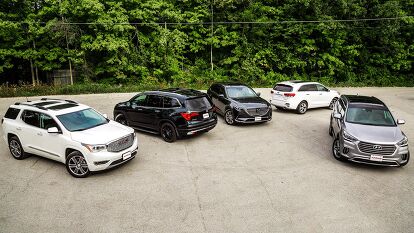



















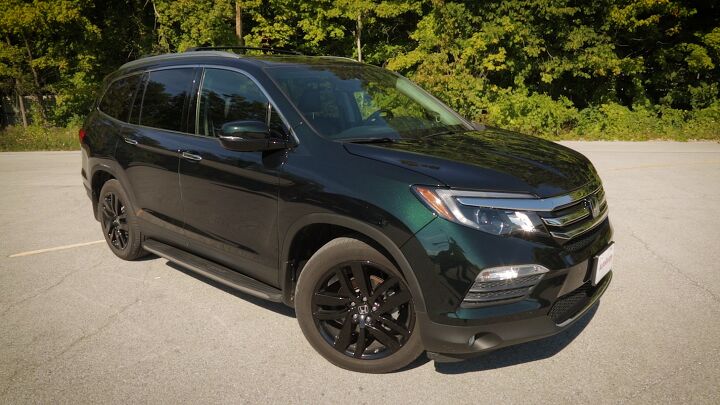


































































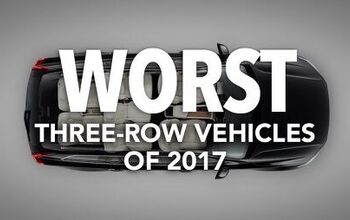
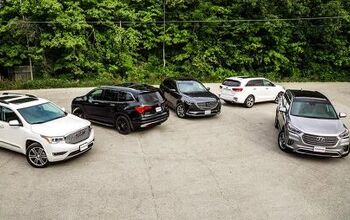
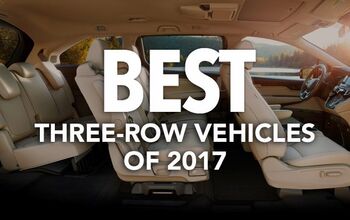
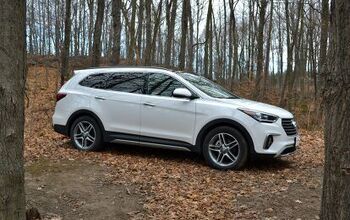

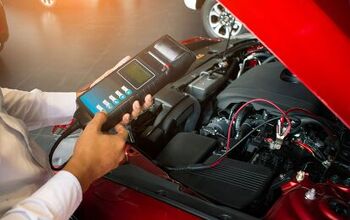

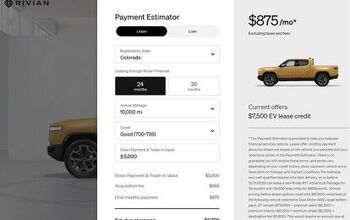
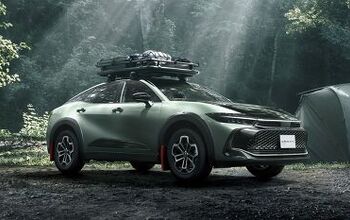




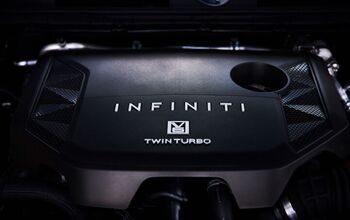
Comments
Join the conversation
Probably the one I'd pick, too. Curious how dramatically opinions of the CX-9 have changed over the last few months. Putting the utility of a mid-size CUV in a full size package (something I've questioned here since day one), hasn't gone over too well after all. Sure it's a great driver, but canyon carving ability is low on the priority list for the intended market. Mazda should have known better.
Honda used to be tops with Toyota, now they are well down in quality and reliability. We will not buy another Honda after having 5 over the recent years. Hondas really suck the big wet one.